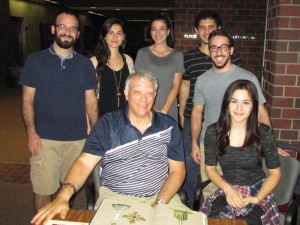Michael Rettig
Staff Writer

Photo: Barlow Der Mugrdechian
One of the most vibrant aspects of Armenian culture is art. Whether it is illuminated manuscripts, domed cathedrals, or khatchkars (stone-crosses), Armenians have passed down a rich artistic heritage. This art gives one a glimpse into the society that created it.
On Wednesday, October 14, Dr. Ron Marchese presented his research on art from the Armenian Churches of Istanbul in his lecture “Treasures of Faith: Reflections on Armenian Society and Culture.” This presentation was part of the Fall Lecture Series of the Armenian Studies Program and was supported by the Leon S. Peters Foundation.
Dr. Marchese has recently published a new book “Treasures of Faith: Sacred Relics and Artifacts from the Armenian Orthodox Churches of Istanbul,” coauthored by Dr. Marlene Breu. It is the second volume in a series based on a study of the art held by the Armenian Patriarchate of Constantinople and in Armenian Churches in Istanbul. Dr. Marchese, who is a Professor of History and Archeology Emeritus at the University of Minnesota-Duluth, approached the art as an archeological site, delving into the context of the objects. He described the value of the art in understanding those who commissioned it.
Dr. Marchese presented artifacts, including church tapestries, liturgical garments, and dove-shaped vessels used for carrying Holy Muron, or Oil. The artifacts, which were all commissioned by laymen rather than aristocrats, demonstrated the religiosity of the donors. Ordinary church members would commission these artifacts as individuals or communities, in order to glorify God. “Each item was considered a statement of faith. Contributions made by one’s own hand instilled within the maker a sense of their own fulfillment and involvement in the spiritual life of the community,” said Dr. Marchese.
Art, as a symbol of one’s faith, inspired the artists to pay particular attention to the smallest of details. “You do not offer mediocre work to God, even if it cannot be seen,” said Dr. Marchese, who demonstrated this by showing detailed icons that were smaller than one’s index finger. It did not matter to the artist that these details would not be seen from the pews as long as he was “honest to the Biblical tradition.”
Dr. Marchese described art in this period as not only a means of giving glory to God, but as a means to educate churchgoers.
“The art has a primary function to depict the historiography of Christianity, which is often difficult to portray. How do you depict that which is not depictable? How do you illustrate the grace of God coming down upon the Mother of God? The artisan has to find a way to do this or they are not being honest to the Biblical tradition,” stated Dr. Marchese.
To achieve this level of expertise, Armenian artists from Istanbul would often travel to Europe, particularly France, for their education. They would bring knowledge and innovation back, which differentiated the more modern art of Constantinople from more conservative art. The Armenians of Istanbul were no longer following the Byzantine tradition and were able to forge their own unique “Constantinople Style.”
Because artifacts were commissioned for religious functions, they never included the personal inscriptions of the artist or donor. “This was a sign of humility,” said Dr. Marchese. “Artists understood that it was not important to include their names.”
By discussing these artifacts from Armenian churches, Dr. Marchese gave the audience a glimpse into the devout lives of those who created them, as well as a broader understanding of the society in which they lived.
 Hye Sharzhoom Armenian Action
Hye Sharzhoom Armenian Action